Simulating Observations in CASA: Difference between revisions
From CASA Guides
Jump to navigationJump to search
| (5 intermediate revisions by 2 users not shown) | |||
| Line 16: | Line 16: | ||
{| class="wikitable" | {| class="wikitable" | ||
! | ! Guide | ||
! Description | |||
! Version History | |||
! Last updated for | |||
|- | |- | ||
! | ! [[Introduction to CASA simulations]] | ||
| This page provides a detailed introduction on how to simulate interferometric data in CASA. | | This page provides a detailed introduction on how to simulate interferometric data in CASA. | ||
| | |||
| style="text-align:center;" | '''CASA 6.5.4''' | |||
|- | |- | ||
! | ! [[Guide To Simulating ALMA Data]] | ||
| This guide gives an introduction to ALMA simulations, and discusses their relevance to ALMA observing proposals. The task {{simalma_6.6.1}} is available to simplify the process of simulating data that combines the 12-m Main Array and the ACA. | | This guide gives an introduction to ALMA simulations, and discusses their relevance to ALMA observing proposals. The task {{simalma_6.6.1}} is available to simplify the process of simulating data that combines the 12-m Main Array and the ACA. | ||
| | |||
| style="text-align:center;" | '''CASA 6.6.1''' | |||
|- | |- | ||
! | ! [[Antenna Configurations Models in CASA]] | ||
| CASA includes configuration files for a large number of interferometers (ALMA, VLA, VLBA, ATCA, CARMA, SMA, PdBI and WSRT). | | CASA includes configuration files for a large number of interferometers (ALMA, VLA, VLBA, ATCA, CARMA, SMA, PdBI and WSRT). | ||
| | | [[Antenna_Configurations_Models_in_CASA_Original | Original]] - [[Antenna_Configurations_Models_in_CASA_Cycle5 | Cycle 5]] - [[Antenna_Configurations_Models_in_CASA_Cycle6 | Cycle 6]] - [[Antenna_Configurations_Models_in_CASA_Cycle8 | Cycle 8]] - [[Antenna_Configurations_Models_in_CASA_Cycle9 | Cycle 9]] - [[Antenna_Configurations_Models_in_CASA_Cycle10 | Cycle 10]] | ||
<!--[[Antenna_Configurations_Models_in_CASA_Cycle_5_draft | Cycle 5 draft]] | <!--[[Antenna_Configurations_Models_in_CASA_Cycle_5_draft | Cycle 5 draft]] | ||
[[Antenna_Configurations_Models_in_CASA_New | draft]]--> | [[Antenna_Configurations_Models_in_CASA_New | draft]]--> | ||
| style="text-align:center;" | '''CASA 6.5.6</br>(ALMA Cycle 10)''' | |||
|} | |} | ||
| Line 48: | Line 49: | ||
{| class="wikitable" | {| class="wikitable" | ||
! | ! Guide | ||
! Description | |||
! Preview Image | |||
! Version History | |||
! Last updated for | |||
|- | |- | ||
! | ! [[Simulating ngVLA Data]] | ||
| This tutorial shows how to create simulated data for the next generation Very Large Array (ngVLA) either by using simobserve or the sm toolkit. Additionally, it shows how to estimate the scaling parameter for adding thermal noise using the sm.setnoise function and the simplenoise parameter. A section is also dedicated to imaging. | |||
| style="text-align:center;" | [[File:ngVLA_pic.png|150px]] | |||
| style="text-align:center;" | [[Simulating_ngVLA_Data-CASA6.7.0 | 6.7.0]] - [[Simulating_ngVLA_Data-CASA5.4.1 | 5.4.1]] | |||
| This tutorial shows how to create simulated data for the next generation Very Large Array (ngVLA) either by using simobserve or the sm toolkit. Additionally, it shows how to estimate the scaling parameter for adding thermal noise using the sm.setnoise function and the simplenoise parameter. | | style="text-align:center;" | '''CASA 6.7.0''' | ||
|- | |||
| | |||
|- | |- | ||
! | ! [[Simalma]] | ||
| This tutorial demonstrates how to use {{simalma_6.6.1}}, a task that simplifies simulations that include the main 12m array plus the ACA. Like the ACA guide, this is of particular interest to those wishing to explore multi-component ALMA observations. | | This tutorial demonstrates how to use {{simalma_6.6.1}}, a task that simplifies simulations that include the main 12m array plus the ACA. Like the ACA guide, this is of particular interest to those wishing to explore multi-component ALMA observations. | ||
|- | | style="text-align:center;" | [[File:M51c.ALMA 0.5arcsec.skymodel.png|200px]] | ||
| | | style="text-align:center;" | [[Simalma_CASA_6.5.4 | 6.5.4]] - [[Simalma (CASA 6.4.1) | 6.4.1]] - [[Simalma (CASA 6.1.1) | 6.1.1]] - [[Simalma (CASA 5.4) v2 | 5.4 v2]] - [[Simalma (CASA 5.4) | 5.4]] - [[Simalma (CASA 5.1) | 5.1]] - [[Simalma (CASA 4.4) | 4.4]] - [[Simalma (CASA 4.3) | 4.3]] - [[Simalma (CASA 4.2) | 4.2]] - [[Simalma (CASA 4.1) | 4.1]] - [[Simalma (CASA 4) original | 4.1 (original)]] | ||
| style="text-align:center;" | '''CASA 6.6.1''' | |||
|- | |- | ||
! | ! [[ACA Simulation]] | ||
| A tutorial for simulating ALMA observations that use multiple configurations or use the 12-meter array in combination with the ALMA Compact Array. This tutorial demonstrates combining data from each ALMA component "by hand". This guide is of particular interest to those wishing to explore using the 12-m array in combination with the ACA, and those interested in combining data from multiple 12-m array configurations. | | A tutorial for simulating ALMA observations that use multiple configurations or use the 12-meter array in combination with the ALMA Compact Array. This tutorial demonstrates combining data from each ALMA component "by hand". This guide is of particular interest to those wishing to explore using the 12-m array in combination with the ACA, and those interested in combining data from multiple 12-m array configurations. | ||
|- | | style="text-align:center;" | [[File:M51c.ALMA 0.5arcsec.skymodel.png|200px]] | ||
| | | style="text-align:center;" | [[ACA_Simulation_(CASA_5.4)_v2 | 5.4 v2]] - [[ACA_Simulation_(CASA_5.4) | 5.4]] - [[ACA_Simulation_(CASA_5.1) | 5.1]] - [[ACA_Simulation_(CASA_4.4) | 4.4]] - [[ACA_Simulation_(CASA_4.3) | 4.3]] - [[ACA_Simulation_(CASA_4.2) | 4.2]] - [[ACA_Simulation_(CASA_4.1) | 4.1]] - [[ACA_Simulation_(CASA_4.0) | 4.0]] - [[ACA_Simulation_(CASA_3.4) | 3.4]] - [[ACA_Simulation_(CASA_3.3) | 3.3]] | ||
| style="text-align:center;" | '''CASA 6.5.4''' | |||
|- | |- | ||
! | ! [[Simulation Guide Component Lists]] | ||
|Tutorial for simulating data based on multiple sources (using both a FITS image and a component list). If you are interested in simulating from a list of simple sources (point, Gaussian, disk), rather than or in addition to a sky model image, then read the considerations here. | |Tutorial for simulating data based on multiple sources (using both a FITS image and a component list). If you are interested in simulating from a list of simple sources (point, Gaussian, disk), rather than or in addition to a sky model image, then read the considerations here. | ||
|- | | style="text-align:center;" | [[File:Analyze_fits_list.jpg|150px]] | ||
| | | style="text-align:center;" | [[Simulation Guide Component Lists (CASA 5.4) | 5.4]] - [[Simulation Guide Component Lists (CASA 5.1) | 5.1]] - [[Simulation Guide Component Lists (CASA 4.4) | 4.4]] - [[Simulation Guide Component Lists (CASA 4.3) | 4.3]] - [[Simulation Guide Component Lists (CASA 4.2) | 4.2]] - [[Simulation Guide Component Lists (CASA 4.1) | 4.1]] - [[Simulation Guide Component Lists (CASA 4.0) | 4.0]] - [[Simulation Guide Component Lists (CASA 3.4) | 3.4]] - [[Simulation Guide Component Lists (CASA 3.3) | 3.3]] | ||
| style="text-align:center;" | '''CASA 6.5.3''' | |||
|- | |- | ||
! | ! [[Protoplanetary Disk Simulation]] | ||
| A sky model with a lightly annotated script that simulates a protoplanetary disk. Uses a theoretical model of dust continuum from Sebastian Wolff, scaled to the distance of a nearby star. This is another fairly generic simulation - if you're short on time, you probably don't need to go through this one and the New Users guide, but it can be useful to go through multiple examples. | | A sky model with a lightly annotated script that simulates a protoplanetary disk. Uses a theoretical model of dust continuum from Sebastian Wolff, scaled to the distance of a nearby star. This is another fairly generic simulation - if you're short on time, you probably don't need to go through this one and the New Users guide, but it can be useful to go through multiple examples. | ||
|- | | style="text-align:center;" | [[File:Psimthumb.png|150px]] | ||
| | | style="text-align:center;" | [[Protoplanetary Disk Simulation (CASA 5.1) | 5.1]] - [[Protoplanetary Disk Simulation (CASA 4.4) | 4.4]] - [[Protoplanetary Disk Simulation (CASA 4.3) | 4.3]] - [[Protoplanetary Disk Simulation (CASA 4.2) | 4.2]] - [[Protoplanetary Disk Simulation (CASA 4.1) | 4.1]] - [[Protoplanetary Disk Simulation (CASA 4.0) | 4.0]] - [[Protoplanetary Disk Simulation (CASA 3.4) | 3.4]] - [[PPdisk simdata (CASA 3.3) | 3.3]] - [[PPdisk simdata (CASA 3.2) | 3.2]] - [[PPdisk simdata (CASA 3.1) | 3.1]] | ||
| style="text-align:center;" | '''CASA 5.4''' | |||
|- | |- | ||
! | ! [[Protoplanetary Disk Simulation - VLA]] | ||
| This tutorial explains the steps for simulating VLA observations using the same protoplanetary disk sky model that was used for the analogous ALMA tutorial. Observational and analysis parameters are changed step by step and the results are compared to the VLA exposure calculator. | |||
| style="text-align:center;" | [[File:VLAsim-psim4mfstclean.png|150px]] | |||
| style="text-align:center;" | [[Protoplanetary_Disk_Simulation_-_VLA-CASA6.4.1 | 6.4.1]] - [[Protoplanetary_Disk_Simulation_-_VLA-CASA6.2.0 | 6.2.0]] - [[Protoplanetary_Disk_Simulation_-_VLA-CASA5.7.0 | 5.7.0]] - [[Protoplanetary_Disk_Simulation_-_VLA-CASA5.5.0 | 5.5.0]] - [[Protoplanetary_Disk_Simulation_-_VLA-CASA5.4.0 | 5.4.0]] - [[Protoplanetary_Disk_Simulation_-_VLA-CASA5.3.0 | 5.3.0]] | |||
| This tutorial explains the steps for simulating VLA observations using the same protoplanetary disk sky model that was used for the analogous ALMA tutorial. Observational and analysis parameters are changed step by step and the results are compared to the VLA exposure calculator. | | style="text-align:center;" | '''CASA 6.5.4''' | ||
|- | |||
| | |||
|- | |- | ||
! | ! Advanced: [[Corrupting Simulated Data (Simulator Tool)]] | ||
| {{simobserve_6.6.1}} calls methods in the {{simulator_6.6.1}} tool. For advanced CASA users, the {{simulator_6.6.1}} tool has methods that can add to simulated data: phase delay variations, gain fluctuations and drift, cross-polarization, and bandpass and pointing errors. {{simulator_6.6.1}} also has more flexibility than {{simobserve_6.6.1}} in adding thermal noise. The tutorial linked from this page describes the simulation of data using the task interface only. The {{simulator_6.6.1}} tool is part of the CASA {{toolkit_6.6.1}}. An examples of advanced techniques for corrupting a simulated MeasurementSet can be found in this CASA Guide on [[Corrupting Simulated Data (Simulator Tool)]]. | | {{simobserve_6.6.1}} calls methods in the {{simulator_6.6.1}} tool. For advanced CASA users, the {{simulator_6.6.1}} tool has methods that can add to simulated data: phase delay variations, gain fluctuations and drift, cross-polarization, and bandpass and pointing errors. {{simulator_6.6.1}} also has more flexibility than {{simobserve_6.6.1}} in adding thermal noise. The tutorial linked from this page describes the simulation of data using the task interface only. The {{simulator_6.6.1}} tool is part of the CASA {{toolkit_6.6.1}}. An examples of advanced techniques for corrupting a simulated MeasurementSet can be found in this CASA Guide on [[Corrupting Simulated Data (Simulator Tool)]]. | ||
| | | | ||
| | | style="text-align:center;" | none | ||
|- | | style="text-align:center;" | n/a | ||
|} | |} | ||
| Line 125: | Line 116: | ||
|- | |- | ||
! | ! Guide | ||
! Description | |||
! Preview Image | |||
! Version History | |||
! Last updated for | |||
|- | |- | ||
! | ! [[Simulation Guide for New Users]] | ||
| A fully annotated tutorial that uses a Spitzer SAGE 8 micron continuum image of 30 Doradus and scales it to greater distance. | | A fully annotated tutorial that uses a Spitzer SAGE 8 micron continuum image of 30 Doradus and scales it to greater distance. | ||
|- | | style="text-align:center;" | [[File:30Dor_ES.png|150px]] | ||
| | | style="text-align:center;" | [[Simulation Guide for New Users (CASA 4.3) | 4.3]] - [[Simulation Guide for New Users (CASA 4.2) | 4.2]] - [[Simulation Guide for New Users (CASA 4.1) | 4.1]] - [[Simulation Guide for New Users (CASA 4.0) | 4.0]] - [[Simulation Guide for New Users (CASA 3.4) | 3.4]] - [[Simulation Guide for New Users (CASA 3.3) | 3.3]] | ||
| style="text-align:center;" | '''CASA 4.4''' | |||
|- | |- | ||
! | ! [[M51 at z = 0.1 and z = 0.3]] | ||
| A fully annotated tutorial that uses a BIMA-SONG cube of a nearby galaxy and scales it to greater distance. | | A fully annotated tutorial that uses a BIMA-SONG cube of a nearby galaxy and scales it to greater distance. | ||
|- | | style="text-align:center;" | [[File:M51thumb.png|150px]] | ||
| | | style="text-align:center;" | [[M51 at z = 0.1 and z = 0.3 (CASA 3.4) | 3.4]] - [[M51 at z = 0.1 and z = 0.3 (CASA 3.3) | 3.3]] - [[M51 at z = 0.1 and z = 0.3 (CASA 3.2) | 3.2]] - [[M51 at z = 0.1 and z = 0.3 (CASA 3.1) | 3.1]] | ||
| style="text-align:center;" | '''CASA 4.0''' | |||
|- | |- | ||
! | ! [[N891 simdata]] | ||
| A sky model, script, and discussion that simulates a nearby edge-on spiral galaxy. Uses a galactic CO cube from the Galactic Ring Survey and places it at 10Mpc. The data are similar to what NGC891 would look like if it were observable from the southern hemisphere. | | A sky model, script, and discussion that simulates a nearby edge-on spiral galaxy. Uses a galactic CO cube from the Galactic Ring Survey and places it at 10Mpc. The data are similar to what NGC891 would look like if it were observable from the southern hemisphere. | ||
|- | | style="text-align:center;" | [[File:N891thumb.png|150px]] | ||
| | | style="text-align:center;" | [[N891 simdata (CASA 3.3) | 3.3]] - [[N891 simdata (CASA 3.2) | 3.2]] | ||
| style="text-align:center;" | '''CASA 3.4''' | |||
|- | |- | ||
! | ! [[Einstein-Face]] | ||
| A sky model and lightly annotated script that simulates the face of Einstein as seen by ALMA. Uses a non-science image to demonstrate the effects of spatial filtering by ALMA. | |||
| style="text-align:center;" | [[File:einstein_fs_cfg8_1hr.gif|150px]] | |||
| style="text-align:center;" | [[Einstein-Face (CASA 4.3) | 4.3]] - [[Einstein-Face (CASA 4.2) | 4.2]] - [[Einstein-Face (CASA 4.1) | 4.1]] - [[Einstein-Face (CASA 4.0) | 4.0]] - [[Einstein-Face (CASA 3.4) | 3.4]] - [[Einstein-Face (CASA 3.3) | 3.3]] - [[Einstein-Face (CASA 3.2) | 3.2]] - [[Einstein-Face (CASA 3.1) | 3.1]] | |||
| A sky model and lightly annotated script that simulates the face of Einstein as seen by ALMA. Uses a non-science image to demonstrate the effects of spatial filtering by ALMA. | | style="text-align:center;" | '''CASA 4.4''' | ||
|- | |||
| | |||
|- | |- | ||
| | |} | ||
| | See also | ||
* [[Sim Inputs | Example input images]] | |||
* [[Sim Outputs | Example output simulations]] | |||
<!-- | <!-- | ||
Latest revision as of 22:02, 7 August 2025
Introduction
This page contains tutorials on how to simulate data in CASA. A detailed overview of how to simulate data in CASA is given in the Simulation notebook of the official CASA Documentation. If you are new to CASA guides, see How To Use A CASAGuide.
Simulating interferometric observations in CASA proceeds in the following steps:
- Make a model image. The model image is a representation of the sky brightness distribution that you would like to simulate observing, stored initially as a FITS file. There are several paths to making the FITS file, discussed below.
- Generate uv data with the simobserve task.
- Image the simulated observation with the simanalyze task.
Getting Started
Get started with these guides.
| Guide | Description | Version History | Last updated for |
|---|---|---|---|
| Introduction to CASA simulations | This page provides a detailed introduction on how to simulate interferometric data in CASA. | CASA 6.5.4 | |
| Guide To Simulating ALMA Data | This guide gives an introduction to ALMA simulations, and discusses their relevance to ALMA observing proposals. The task simalma is available to simplify the process of simulating data that combines the 12-m Main Array and the ACA. | CASA 6.6.1 | |
| Antenna Configurations Models in CASA | CASA includes configuration files for a large number of interferometers (ALMA, VLA, VLBA, ATCA, CARMA, SMA, PdBI and WSRT). | Original - Cycle 5 - Cycle 6 - Cycle 8 - Cycle 9 - Cycle 10 | CASA 6.5.6 (ALMA Cycle 10) |
Tutorials
These tutorials are actively maintained.
| Guide | Description | Preview Image | Version History | Last updated for |
|---|---|---|---|---|
| Simulating ngVLA Data | This tutorial shows how to create simulated data for the next generation Very Large Array (ngVLA) either by using simobserve or the sm toolkit. Additionally, it shows how to estimate the scaling parameter for adding thermal noise using the sm.setnoise function and the simplenoise parameter. A section is also dedicated to imaging. | 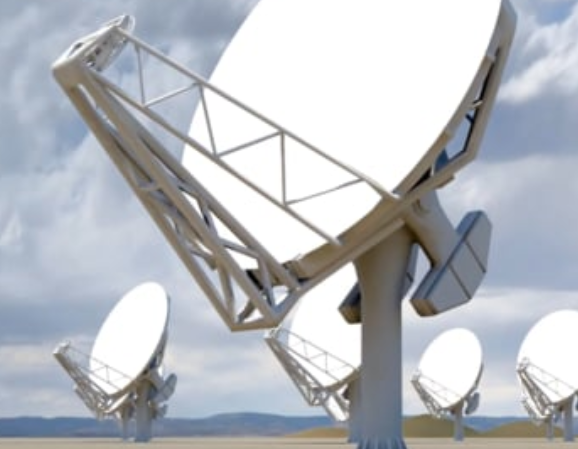
|
6.7.0 - 5.4.1 | CASA 6.7.0 |
| Simalma | This tutorial demonstrates how to use simalma, a task that simplifies simulations that include the main 12m array plus the ACA. Like the ACA guide, this is of particular interest to those wishing to explore multi-component ALMA observations. | 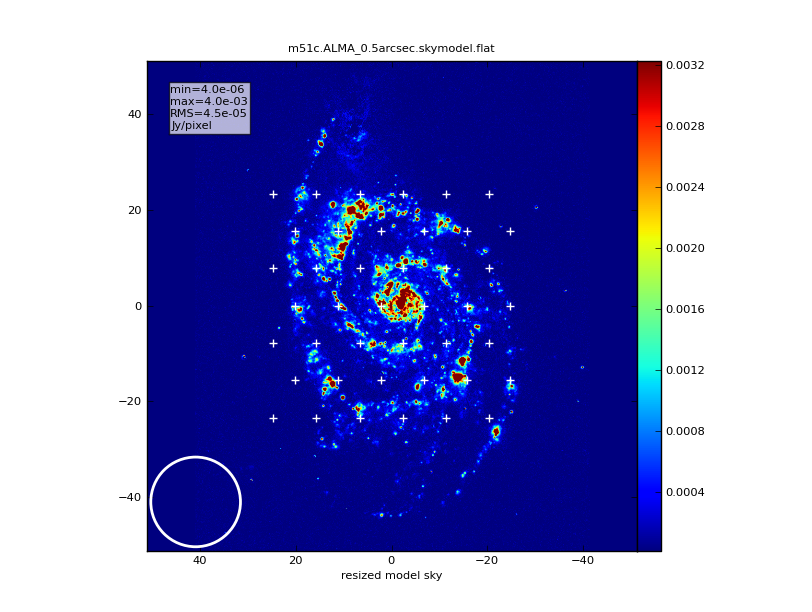
|
6.5.4 - 6.4.1 - 6.1.1 - 5.4 v2 - 5.4 - 5.1 - 4.4 - 4.3 - 4.2 - 4.1 - 4.1 (original) | CASA 6.6.1 |
| ACA Simulation | A tutorial for simulating ALMA observations that use multiple configurations or use the 12-meter array in combination with the ALMA Compact Array. This tutorial demonstrates combining data from each ALMA component "by hand". This guide is of particular interest to those wishing to explore using the 12-m array in combination with the ACA, and those interested in combining data from multiple 12-m array configurations. | 
|
5.4 v2 - 5.4 - 5.1 - 4.4 - 4.3 - 4.2 - 4.1 - 4.0 - 3.4 - 3.3 | CASA 6.5.4 |
| Simulation Guide Component Lists | Tutorial for simulating data based on multiple sources (using both a FITS image and a component list). If you are interested in simulating from a list of simple sources (point, Gaussian, disk), rather than or in addition to a sky model image, then read the considerations here. | 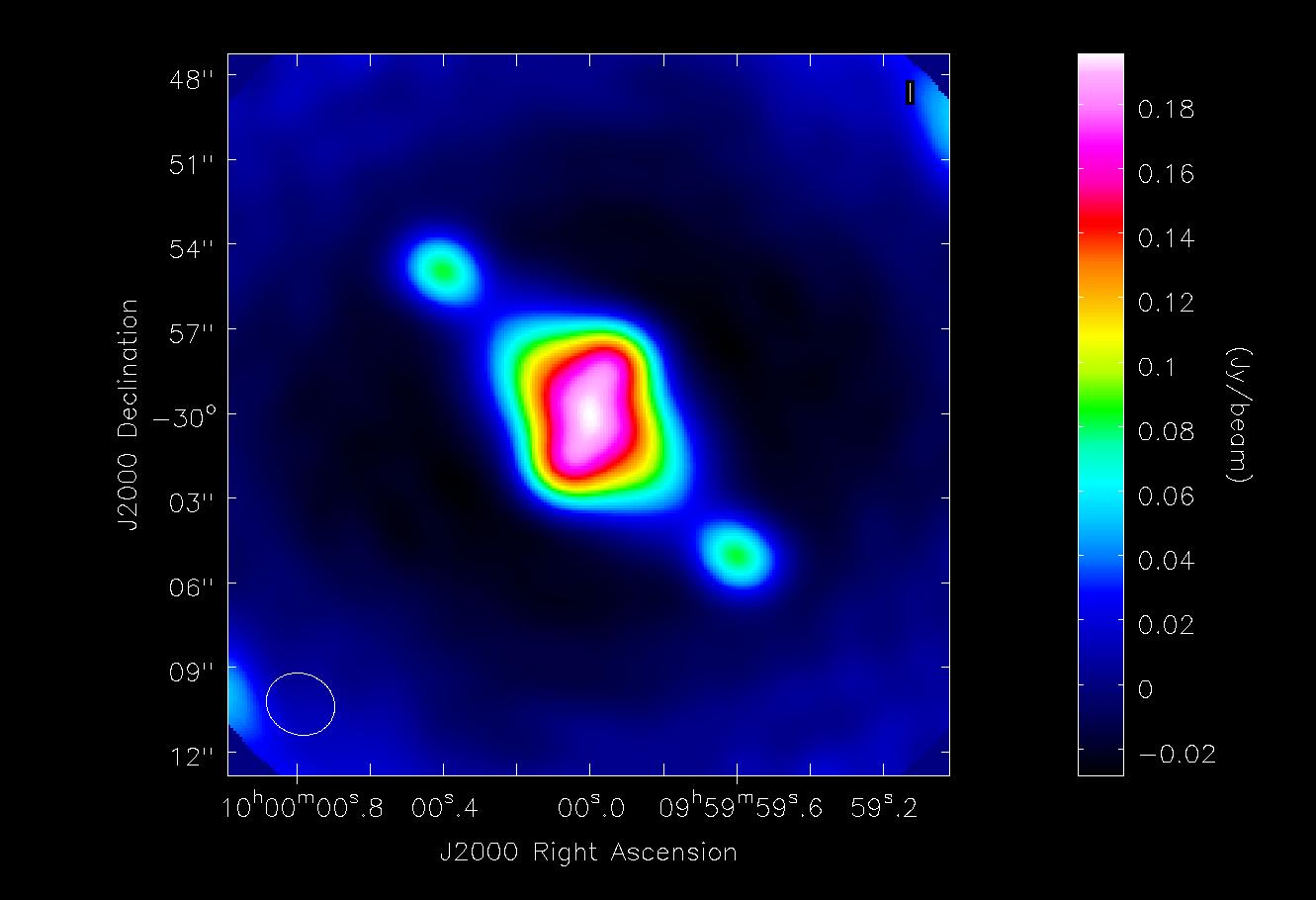
|
5.4 - 5.1 - 4.4 - 4.3 - 4.2 - 4.1 - 4.0 - 3.4 - 3.3 | CASA 6.5.3 |
| Protoplanetary Disk Simulation | A sky model with a lightly annotated script that simulates a protoplanetary disk. Uses a theoretical model of dust continuum from Sebastian Wolff, scaled to the distance of a nearby star. This is another fairly generic simulation - if you're short on time, you probably don't need to go through this one and the New Users guide, but it can be useful to go through multiple examples. | 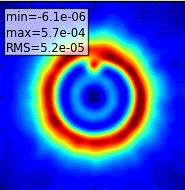
|
5.1 - 4.4 - 4.3 - 4.2 - 4.1 - 4.0 - 3.4 - 3.3 - 3.2 - 3.1 | CASA 5.4 |
| Protoplanetary Disk Simulation - VLA | This tutorial explains the steps for simulating VLA observations using the same protoplanetary disk sky model that was used for the analogous ALMA tutorial. Observational and analysis parameters are changed step by step and the results are compared to the VLA exposure calculator. | 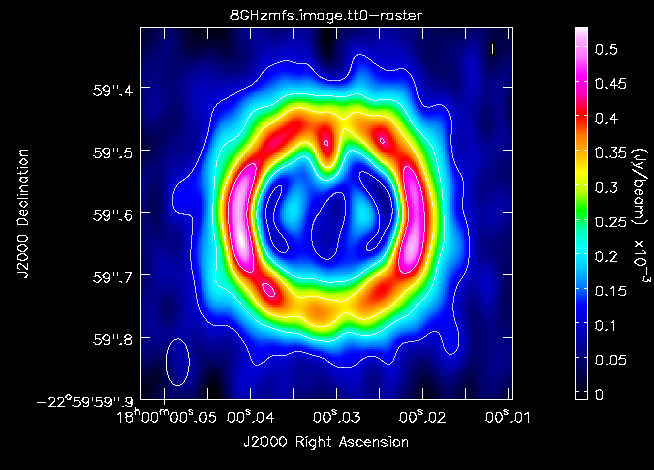
|
6.4.1 - 6.2.0 - 5.7.0 - 5.5.0 - 5.4.0 - 5.3.0 | CASA 6.5.4 |
| Advanced: Corrupting Simulated Data (Simulator Tool) | simobserve calls methods in the simulator tool. For advanced CASA users, the simulator tool has methods that can add to simulated data: phase delay variations, gain fluctuations and drift, cross-polarization, and bandpass and pointing errors. simulator also has more flexibility than simobserve in adding thermal noise. The tutorial linked from this page describes the simulation of data using the task interface only. The simulator tool is part of the CASA toolkit. An examples of advanced techniques for corrupting a simulated MeasurementSet can be found in this CASA Guide on Corrupting Simulated Data (Simulator Tool). | none | n/a |
Archived Tutorials
These tutorials are no longer updated.
| Guide | Description | Preview Image | Version History | Last updated for |
|---|---|---|---|---|
| Simulation Guide for New Users | A fully annotated tutorial that uses a Spitzer SAGE 8 micron continuum image of 30 Doradus and scales it to greater distance. | 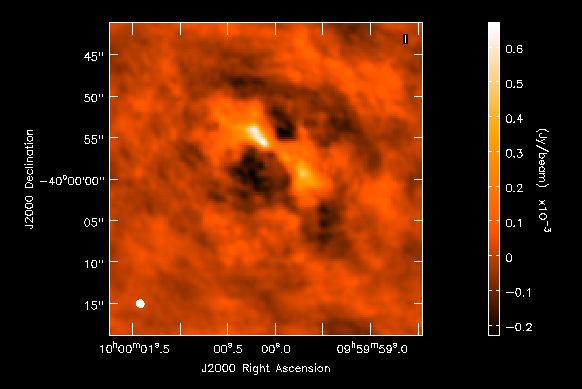
|
4.3 - 4.2 - 4.1 - 4.0 - 3.4 - 3.3 | CASA 4.4 |
| M51 at z = 0.1 and z = 0.3 | A fully annotated tutorial that uses a BIMA-SONG cube of a nearby galaxy and scales it to greater distance. | 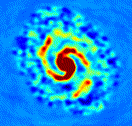
|
3.4 - 3.3 - 3.2 - 3.1 | CASA 4.0 |
| N891 simdata | A sky model, script, and discussion that simulates a nearby edge-on spiral galaxy. Uses a galactic CO cube from the Galactic Ring Survey and places it at 10Mpc. The data are similar to what NGC891 would look like if it were observable from the southern hemisphere. | 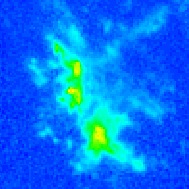
|
3.3 - 3.2 | CASA 3.4 |
| Einstein-Face | A sky model and lightly annotated script that simulates the face of Einstein as seen by ALMA. Uses a non-science image to demonstrate the effects of spatial filtering by ALMA. | 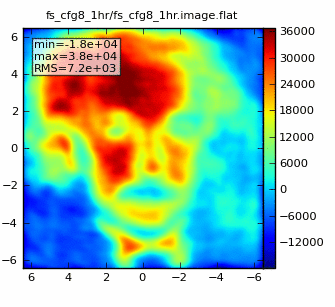
|
4.3 - 4.2 - 4.1 - 4.0 - 3.4 - 3.3 - 3.2 - 3.1 | CASA 4.4 |
See also
User Feedback
We welcome input on developing the CASA simulator. Contact casa-feedback@nrao.edu if you would like to volunteer your input.